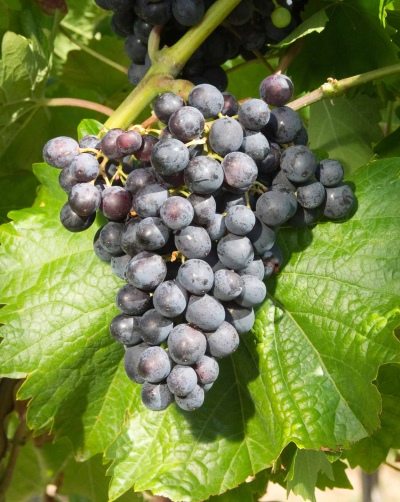
- Authors: Garnier, Switzerland
- Appointment: universal
- Berry color: black
- Taste: nutmeg
- Ripening period: early
- Ripening period, days: 110-115
- Frost resistance, ° C: -22
- Name synonyms: Garnier 83/2
- Bunch weight, g: 250-300
- Flower type: bisexual
The Muscat Blau grape is one of the most popular varieties due to its ability to make a very aromatic and tasty wine from it. This nutmeg variety is highly regarded by even the most demanding gardeners.
Breeding history
The variety, also called Garnier 83/2, was developed thanks to Charles Garnier in Switzerland in the 30s of the XX century. The result is a fragrant and tasty grape crossing Garnier 15/6 (Save Villars 18-315 x Müller Thurgau) and Save Villars 20-347, which were quite popular in Greece in the middle of the 19th century. It was there that the highest quality and most worthy wines were produced.
Geography of distribution
Blau Muscat is actively cultivated in Switzerland and also abroad. He can often be seen in the gardens of Belgium.
Description
Vigorous bushes have many advantages. But in order to understand what a variety is, it is necessary to study its characteristics.
Ripening period
The cultivar is early and matures in late summer. The ripening period is about 110-115 days. It is recommended to collect the bunches not immediately after they begin to ripen, but towards the end of September or even in October, if the climatic conditions are sparing.
Bunches
The bunch is medium in size and round in shape, it is rather loose due to the loose fit of the berries to each other. The weight of one varies from 250 to 300 g.
Berries
The fruits are large and round, black in color, with not too dense pulp. One grape has an average weight of about 3.5 g.
Berries have a universal purpose, so they can be consumed in their pure form, as well as to prepare various drinks from them.
Taste
The fruits have a pleasant, harmonious nutmeg taste.
Yield
High-yielding variety. In the first year after planting, 2-3 clusters are collected from the bush. If you grow a crop in a greenhouse, it will delight gardeners with a harvest from 2 years old and will bear fruit until November.


Growing features
It is not too difficult to grow these grapes, it is only important to take into account the climatic conditions.
Landing
Farmers note that the variety is completely unpretentious, and it does not matter to which soil the seedling is planted. Culture likes warmth and heat, so it is not recommended to plant it in the northern parts of the Russian Federation. If grapes are nevertheless planted in cold conditions, care should be taken to make them feel as comfortable as possible, otherwise the harvest may not wait.
It should be planted on the side of the site where there will be enough sunlight. In such conditions, the plant will be able to grow quickly and develop well.

Pollination
Thanks to bisexual flowers, the culture does not need third-party pollinators.
Pruning
Recommended pruning is to leave 3-5 eyes on each vine.

Watering
If the weather is dry and hot, you need to water the plants several times in 7 days. In case of rain, the irrigation should be reduced slightly.


Top dressing
You need to feed the variety regularly and in a timely manner. Complex fertilizers are used, which contain many minerals and vitamins.
Frost resistance and the need for shelter
The variety tolerates frost well down to -22 degrees and does not need shelter in winter.

Diseases and pests
Blau Muscat is resistant to diseases such as mildew and powdery mildew. They affect the plant to a moderate extent. In order to fully protect the culture, it is necessary to carry out the prevention of spraying using chemical and biological agents.
Bushes are most often affected by wasps, which can cause significant damage to ripe fruit. To avoid this problem, it is recommended to protect the grapes with a network.

If a grape is exposed to any disease or insect, this always affects its appearance.
Storage
The bunches can be kept fairly well if you create comfortable conditions for them.











































































